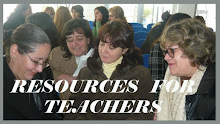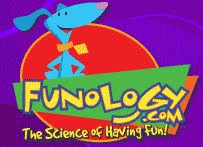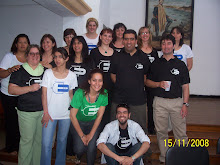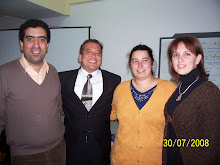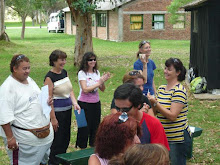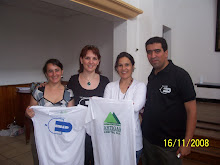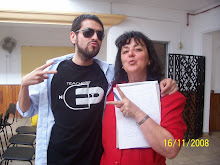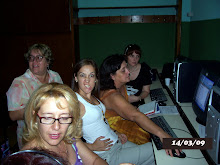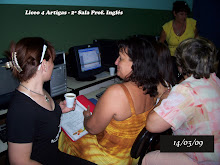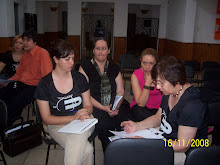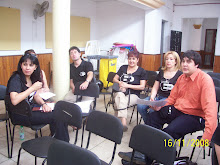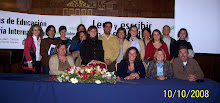One of the most challenging aspects of being an educator in today´s world is keeping up with the constantly changing technology. It often feels like we can never catch up to students´ level of understanding, let alone teach them something new. Yet, we know that if we don´t utilize technology in the classroom, we risk leaving students unprepared for the world where they will live and work.
In my own struggles with this dilemna, I have searched for ways to use technology as a vehicle for language learning rather than focussing solely on teaching students about technology. By doing this, I´ve found that there are many ways use technology in the English classroom that don´t require a deep understanding on the teacher´s part. As I have used them with my students, I´ve found that they are not only easy to use, but also very engaging for students.
If you are interested in taking a look at some of the internet resources I´ve found useful, click on the following link to my blog about technology in the classroom: http://englishtechnologyuy.blogspot.com/
Kelly Gardner
English Language Fellow
Inspección de Inglés
Teachersnetuy
View more presentations from beasen17.
"When teachers have a strong sense of professional community their morale is better and teacher commitment is higher. Professional community helps support teaching practices, and helps teachers address the uncertainty that accompanies nonroutine teaching of the sort encouraged by many school reform initiatives."
Adam Gamoran
Adam Gamoran
It is often said that the most important asset of any enterprise is the talent and enthusiasm of its workforce. Education is no exception to this premise.
Being teachers such a vital element in the educational process, when designing policies aimed at getting better academic results, what policymakers must not forget is that teachers are no different from employees in the private sector. They want to succeed in their jobs and they demand the tools, the respect, and the sense of empowerment necessary to reach this goal.
As University of Washington scholar Dan Goldhaber stands, "It appears that the most important thing a school can do, is to provide its students with good teachers".
But teachers are known to improve when they analyze, evaluate, and experiment with colleagues in purposeful learning communities (Fullan, 2001). Fullan also suggests that the school level change strategy is developing professional learning community within schools and emphasize the importance of strong teacher community. Therefore, teachers need to be enabled and encouraged to establish a community of learners among themselves (Lave & Wegner, 1991). Maclaughlin and Talbert (2001) also indicated that a collaborative community of practice in which teachers share instructional resources and reflections in practice appear essential to their persistence and success in innovating classroom practices (p.22).
Building up organizations that are able to learn – according to Kofman and Senge- requires basic changes in the ways people think and interact. “The heart of the learning organizations are communities of commitment. Without communities of people genuinely committed to the organizations’ goals, there is no real change”.

WEATHER FORECAST
"Shapers" 2007: the net is officially born
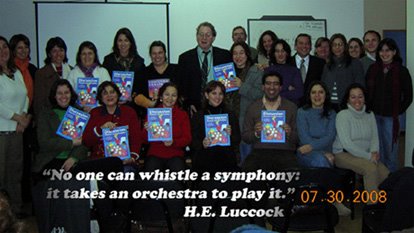
NEW MESSAGE. CHECK IT OUT!
martes, 28 de abril de 2009
jueves, 23 de abril de 2009
miércoles, 22 de abril de 2009
EARTH DAY 2009: THE GREEN GENERATION

Earth Day 2009, April 22, will mark the beginning of The Green Generation CampaignTM which will also be the focus of the 40th Anniversary of Earth Day in 2010. With negotiations for a new global climate agreement coming up in December, Earth Day 2009 must be a day of action and civic participation, to defend The Green GenerationTM’s core principles:
A carbon-free future based on renewable energy that will end our common dependency on fossil fuels, including coal.
An individual’s commitment to responsible, sustainable consumption.
Creation of a new green economy that lifts people out of poverty by creating millions of quality green jobs and transforms the global education system into a green one.
A carbon-free future based on renewable energy that will end our common dependency on fossil fuels, including coal.
An individual’s commitment to responsible, sustainable consumption.
Creation of a new green economy that lifts people out of poverty by creating millions of quality green jobs and transforms the global education system into a green one.


Note:Earth Day Founder Gaylord Nelson passed away July 2005 at the age of 89. He believed strongly that education is the key to changing people's attitudes about the environment and he devoted much of his energy to that challenge.
By Senator Gaylord Nelson, Founder of Earth Day
What was the purpose of Earth Day? How did it start? These are the questions I am most frequently asked.
Actually, the idea for Earth Day evolved over a period of seven years starting in 1962. For several years, it had been troubling me that the state of our environment was simply a non-issue in the politics of the country. Finally, in November 1962, an idea occurred to me that was, I thought, a virtual cinch to put the environment into the political "limelight" once and for all. The idea was to persuade President Kennedy to give visibility to this issue by going on a national conservation tour. I flew to Washington to discuss the proposal with Attorney General Robert Kennedy, who liked the idea. So did the President. The President began his five-day, eleven-state conservation tour in September 1963. For many reasons the tour did not succeed in putting the issue onto the national political agenda. However, it was the germ of the idea that ultimately flowered into Earth Day.
I continued to speak on environmental issues to a variety of audiences in some twenty-five states. All across the country, evidence of environmental degradation was appearing everywhere, and everyone noticed except the political establishment. The environmental issue simply was not to be found on the nation's political agenda. The people were concerned, but the politicians were not.
After President Kennedy's tour, I still hoped for some idea that would thrust the environment into the political mainstream. Six years would pass before the idea that became Earth Day occurred to me while on a conservation speaking tour out West in the summer of 1969. At the time, anti-Vietnam War demonstrations, called "teach-ins," had spread to college campuses all across the nation. Suddenly, the idea occurred to me - why not organize a huge grassroots protest over what was happening to our environment?
I was satisfied that if we could tap into the environmental concerns of the general public and infuse the student anti-war energy into the environmental cause, we could generate a demonstration that would force this issue onto the political agenda. It was a big gamble, but worth a try. . .
Read the whole article at http://earthday.wilderness.org/history/
Suscribirse a:
Entradas (Atom)








